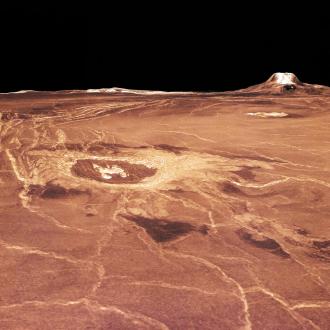A roiling, pressurized ball whose metal-liquifying surface is buried beneath a violent, acid-cloud atmosphere, Venus is Earth’s Evil Sister, a sinister mirror image — down to rotating around its axis the opposite way.
One of the defining features of this cartoonishly uninhabitable world is its volcanoes. Now, researchers at Washington University in St. Louis have created a planet-spanning volcano map containing all of the ones we’ve discovered thus far — 85,000 or so.
“This paper provides the most comprehensive map of all volcanic edifices on Venus ever compiled,” Paul Byrne, associate professor of earth and planetary sciences and one of the volcano map’s creators, said.
The gifts of Magellan: Byrne and graduate student and first author Rebecca Hahn’s volcano map, to be published in JGR Planets, is the product of a probe that’s been dead for decades.
NASA’s Magellan spacecraft arrived in Venus’ orbit in 1990. Using a special type of radar, Magellan’s mission was to map the Venusian surface, becoming the first probe to do so. That radar imagery, which covered 98% of the planet at a resolution of 390 to 985 feet, was part of a record-breaking 1,200 gigabytes of data returned from around Venus — more data than all of NASA’s planetary missions combined at that time.
But in an era before AI-enhanced analysis and with images taken from different spots and at different angles — not to mention the resolution — working with that data was exhausting.
“People back then were manually hand-drawing circles around the volcanoes, when I can just do it on my computer,” Hahn said.
Using a mapping and analysis software called ArcGIS, the researchers rebuilt their volcano map from Magellan’s imagery. “It was tedious, but I had experience using ArcGIS software, which is what I used to build the map,” Hahn said. “That tool wasn’t available when these data first became available back in the ’90s.”
As researchers gear up for the upcoming VERITAS Venus mission, they’ve continued to glean new insights from the old probe’s data; recent analysis of imagery found evidence that Venus may have active volcanic activity.
“Since NASA’s Magellan mission in the 1990s, we’ve had numerous major questions about Venus’ geology, including its volcanic characteristics,” Byrne said.
“But with the recent discovery of active volcanism on Venus, understanding just where volcanoes are concentrated on the planet, how many there are, how big they are, etc., becomes all the more important — especially since we’ll have new data for Venus in the coming years.”
The volcano map: Hahn and Byrne’s volcano map aims to provide an as-comprehensive-as-possible understanding of Venus’ many, many volcanoes. (In fact, without an ocean hiding its secrets, like Earth, it may be the most comprehensive study of volcanism on any planet.)
It includes not only their location, but analyses of how they are grouped together and how their position compares to other geophysical properties, like crust thickness. All told, the map contains 85,000 volcanoes, in sundry shapes and sizes — and that may be a lowball, Hahn said, with smaller volcanoes missed as Magellan ran up against the limits of 1990s’ technology.
“A volcano 1 kilometer in diameter in the Magellan data would be 7 pixels across, which is really hard to see,” Hahn said. “But with improved resolution, we could be able to resolve those structures.”
The entire volcano map and data set is publicly available for use.
Questions about volcano shape, size, distribution, activity — any of it could potentially be explored with the data, Byrne noted.
Take, for example, the mystery of Venus’ internal heat venting and origins of its famously brutal atmosphere. Unlike Earth, Venus does not have plate tectonics, which helps release our world’s excess internal heat, Brown University professor and Venus researcher James W. Head tells Freethink.
“How then does Venus get rid of its heat? One way is to have lots of volcanic activity and at very high rates over geologic time,” Head says.
The new volcano map may provide evidence that the volcanoes may have been a better heat release valve than plate tectonics, and “may have even contributed CO2 and other gasses to the atmosphere, making Venus’ currently hellish atmosphere so different from that of Earth,” Head says.
It’s the exact kind of research the Washington University team was hoping the volcano map and data can spark.
“We’ve already heard from colleagues that they’ve downloaded the data and are starting to analyze it — which is exactly what we want,” Byrne said. “I’m excited to see what they can figure out with the new database!”
We’d love to hear from you! If you have a comment about this article or if you have a tip for a future Freethink story, please email us at tips@freethink.com.
